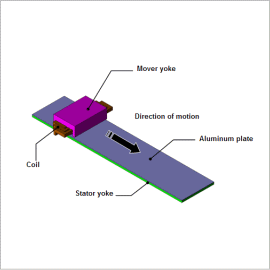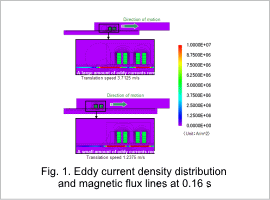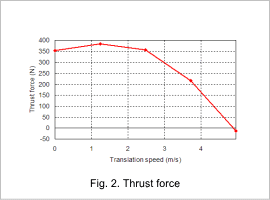*Please prepare a license ID and password for the license administrator.
*It is different from the service for JMAG WEB MEMBER (free membership). Please be careful.
Overview

Linear motors are widely used for carrier devices and machine tools because of their high-speed performance, high acceleration and deceleration, and accurate positioning. One type of linear motor, the linear induction motor, can be constructed at low cost because it can use a primary side with coils, and a secondary side made of a conductor that is not magnetized, such as aluminum or copper.
Linear induction motors have unique phenomena called end effects that cause reduced performance at low slip, so it is important to grasp thrust force characteristics, including end effects, using magnetic field analysis when evaluating these motors.
This Application Note presents how to obtain thrust force characteristics for a linear inductance motor.
Linear induction motors have unique phenomena called end effects that cause reduced performance at low slip, so it is important to grasp thrust force characteristics, including end effects, using magnetic field analysis when evaluating these motors.
This Application Note presents how to obtain thrust force characteristics for a linear inductance motor.
Eddy Current Density Distribution

The eddy current density distribution and magnetic flux lines are shown in fig. 1. Thrust force is produced through the interaction between the eddy currents and magnetic field when eddy currents occur in the aluminum sheet due to variations in the magnetic field created by the coils.
More eddy currents remain behind the motor at a translation speed of 3.7125 m/s than at a translation speed of 1.2375 m/s, as indicated in fig. 1. This is because variations in magnetic flux to the rear of the motor increase as the translation speed is increased.
More eddy currents remain behind the motor at a translation speed of 3.7125 m/s than at a translation speed of 1.2375 m/s, as indicated in fig. 1. This is because variations in magnetic flux to the rear of the motor increase as the translation speed is increased.
Thrust Force

The thrust force characteristics are shown in fig. 2. When this linear induction motor starts from a stationary state and accelerated to a synchronous speed, the thrust force reaches a maximum of 360 N at a translation speed of 1.2375 m/s and then falls thereafter. This is because the amount of variation in the magnetic flux in the aluminum sheet is reduced as the variation in the magnetic field generated by the coil reaches a synchronous speed.


